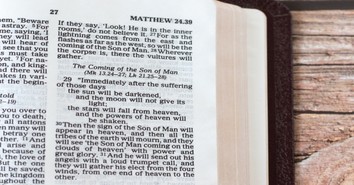How Does Knowing How the Chiasm Works Transform Our Bible Reading?

You may have heard your pastor or Bible scholar refer to a passage of Scripture as a “chiasm” or “chiasmus.” Perhaps it’s a new term to you. Or maybe you know what it means, but you wonder, “So what? What does it matter?”
Does recognizing a chiasm in the Bible make any difference in how we read God’s Word? Can identifying chiastic passages enhance our time spent in God’s Word?
What Does Chiasm Mean?
A chiasm is a literary term for a structure that repeats similar ideas in reverse sequence. The second half of a chiasm mirrors the first, with the main point or core teaching in the center. It comes from the Greek word chi, which looks like the English letter X. Chiasmus means “crossing” or “X” shaped. Its mirrored structure allows ideas to crisscross.
A chiasm reflects words or phrases connected with the principal idea, just in the opposite order. It was a common literary device in ancient literature, including Hebrew, Greek, and Latin. As modern Western readers, we expect the passage’s most important part to be at the beginning or end. However, in the Eastern ancient cultures of the Bible, the main point often sat in the middle.
A chiasm can shed light on what the writer, under the Holy Spirit’s direction, wanted most to impart. We risk missing the central point if we ignore how the authors intended us to read the lines.
Why Should We Know What a Chiasm Is?
The Bible is undisputedly the best-selling book of all time, yet relatively few people are truly Bible literate. The root lies in knowing how to read and study Scripture correctly. Its message transforms the heart and guides our lives and actions. When the Word of God takes root in our lives, our entire attitude toward reading the Bible changes.
Understanding “chiasm” in Scripture can open our eyes to one of the structures God implemented into the authors’ language. It alerts us to repetitions and emphasis. Seeing the divinely placed patterns in God’s Word helps unveil the principal thoughts the writer intended for our understanding.
No other book is like the Bible. Comprised of 66 books, the Bible was written by approximately 40 writers of different backgrounds, ages, and cultures over 1,500 years. Yet, its message is cohesive and purposeful. God’s Word points to Jesus as Messiah and salvation as His gift. But what makes it most distinctive from all other books is that the Bible is divinely inspired.
Chiasms in the Bible help us understand a passage’s emphasis and core teaching. Seeing these within a text helps bridge gaps in language, culture, geography, and history. The better we understand the context within those perimeters, the more the Bible comes alive for us today.
What Are Some Modern Examples of Chiastic Structure?
While Chiasms may not appear as often in modern Western literature, we still see them today. Chiastic patterns appear in many familiar quotes and axioms like the following:
John F. Kennedy’s famous statement:
A-Ask not what your country
B-Can do for you;
B-ask what you can do
A-for your country.
Benjamin Franklin’s proverb:
A-By failing
B-to prepare,
B-you are preparing
A-to fail.
But there is more to _.
What Are the Two Kinds of Chiasms?
Chiasms are structured in two basic ways. A-B and B-A (ABBA), with A and B repeating the same idea in reverse order. The second structure inserts another idea X between them (ABXBA).
An example of ABBA is Jesus’ words in Mark 2:27 (quoted here from the NKJV):
A-The Sabbath was made
B-for man
B-Not man
A-for the Sabbath.
The first phrase is inverted in the following phrase, and the idea ending the first phrase begins the second. Although the wording of a chiasm does not have to be the same in both phrases, it must contain similar, opposite, or related words.
For example, here is what Jesus said in Matthew 6:24 (quoted here from the ESV):
A-No one can serve two masters,
B-for either he will hate the one
C-and love the other,
C-or he will be devoted to the one
B-and despise the other.
A-You cannot serve God and money.
In Matthew 6:24, the center unlocks the main teaching by emphasizing that the master we love is the master we will serve.
Longer chiasms add more alphabet letters to break down the phrases (ABCDDCBA), etc.
Examples of ABXBA are often found in larger and more complex passages. The X is a third idea inserted between the mirrored repetition for emphasis.
John 11:25-26 (quoted here from the ESV) shows us how the X hinges the other two parts while setting itself apart.
Jesus said to her,
A-I am the resurrection and the life.
B-Whoever believes in me,
C-though he die,
X-yet shall he live,
C-everyone who lives
B-and believes in me
A-shall never die. Do you believe this?
Variations of the two chiasms span sections of verses and even whole chapters. For example, Joel 3:17-21 has seven parts. The pivotal X is found in verse 18, discussing the blessings of God’s kingdom, sandwiched within mirrored prophecies of God’s dwelling, Jerusalem, and foreign adversaries.
What Are Some Famous Chiasms in the Bible?
Many Bible scholars see chiastic structures in large swaths of Scripture. For example, Psalm 46 and Psalm 23 put their main points in the center. Reading the chapters and realizing that the main teaching works out from the core gives a clearer overall understanding. Large chunks of Scripture, like the creation in Genesis 1, the Sermon on the Mount, and the Beatitudes, use more complex chiasms.
Here are a few of the more familiar ones.
“And whoever exalts himself will be humbled, and he who humbles himself will be exalted.” (Matthew 23:12 NKJV)
“Love your enemies, bless those who curse you, do good to those who hate you, and pray for those who spitefully use you and persecute you.” (Matthew 5:44 NKJV)
“And he will turn the hearts of the fathers to the children, And the hearts of the children to their fathers. Lest I come and strike the earth with a curse.” (Malachi 4:6 NKJV)
Chiasms do not replace proper hermeneutical methods of interpretation. We certainly do not need additional literary traits added to Scripture, nor should we deviate from historical-grammatical methods of interpretation. But as we study the Bible, recognizing a chiasm can help clarify and enrich our understanding of what the passage teaches.
What Do Chiasms Tell Us about the Bible as Literature?
Literature is defined as a body of written works or form of expression. We might cringe when we think of the Bible as literature because it is set apart from other books—and it should be.
The Apostle Paul says, “All Scripture is given by inspiration of God, and is profitable for doctrine, for reproof, for correction, for instruction in righteousness, that the man of God may be complete, thoroughly equipped for every good work.” (2 Timothy 3:16-17 NKJV)
As we approach God’s Word, we can be completely confident that, unlike other literature, it is infallible in its totality, inerrant, authoritative, true, and final. When we open its pages, we are certain Scripture speaks for itself, interpreting Scripture with Scripture, setting itself apart from all other forms of literature.
Chiasms are one way the writers demonstrate attention to wordcraft and intentional delivery of themes and ideas. The Bible is divine literature written about God so that we might know God. The use of chiastic structure creates harmony, balance, and rhythm, making its literary quality rich and complex.
John writes in John 1:1-2 “In the beginning was the Word, and the Word was with God, and the Word was God. He was in the beginning with God.” (NKJV)
John uses the Word (in the Greek, Logos) to describe Jesus as Ever-Existing-One-With-God. He created the physical world and all divine reasoning and thought.
In English, 26 distinct letters of the alphabet comprise our language as we combine and move them about. They are our written and verbal communication. We express ourselves by stringing them together to form words and sentences. But as with every language, we do not own them.
We attempt to parse and fit them together. But all of it, its patterns and distinctions were first created by Logos, The Word. As we read His Inspired Word, we can only be amazed to find He also organized those words for them to enter our minds and hearts, to bring reason and understanding for life and eternity.
God made His Word interesting to us. He ordained its authors to express His words and thoughts in a way that transforms and remains with us. He uses poetic beauty and practical instructions to bring us divine literature without error.
While we may have felt indifferent in the past to literary devices such as chiasms within the historical text of God’s Word, there is much to learn from the structures those ancient authors used. The Bible is a book by God so that we might know God. Our goal is to understand with the ears and intent of the writer and to embrace context and gap culture. Our lives transform as we implement and apply what He says with growing understanding.
Photo Credit:©GettyImages/pcess609

Her love for pasta and all things Italian stems from years of ministry abroad. She’d love to tell you about it over a steaming cup of cappuccino. Connect with Sylvia on her blog, When the House is Quiet, her Facebook page, or Twitter.
Originally published May 17, 2024.





